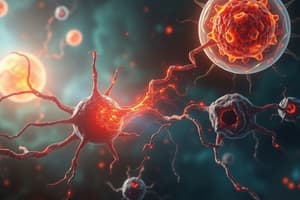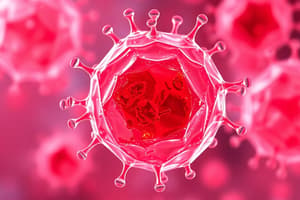Podcast
Questions and Answers
What are common abnormalities seen in cell injury at the microscopic and functional levels?
What are common abnormalities seen in cell injury at the microscopic and functional levels?
- Enhanced nutrient metabolism and functional disturbances
- Increased oxygen supply and intracellular alkalosis
- Cell shrinking and increased nuclear material
- Cell swelling and membrane rupture (correct)
Which process can lead to hypoxic injury resulting in decreased oxygen supply?
Which process can lead to hypoxic injury resulting in decreased oxygen supply?
- Enhanced immune response
- Respiratory diseases
- Cardiovascular diseases (correct)
- Increased oxygenation of tissues
How do chemicals like cyanide and carbon monoxide damage cells?
How do chemicals like cyanide and carbon monoxide damage cells?
- Inducing intracellular alkalosis
- Boosting immune system response
- Increasing nutrient metabolism
- Preventing adequate oxygenation of tissues (correct)
What can increase the likelihood of cell damage from infectious agents?
What can increase the likelihood of cell damage from infectious agents?
What are symptoms commonly associated with inflammatory responses triggered by physical, chemical, or microbiologic agents?
What are symptoms commonly associated with inflammatory responses triggered by physical, chemical, or microbiologic agents?
Which of the following is NOT a mechanism through which chemicals can damage cells?
Which of the following is NOT a mechanism through which chemicals can damage cells?
Flashcards are hidden until you start studying
Study Notes
- Cellular injury can be caused by various processes including hypoxia, chemical exposure, infectious agents, hypersensitivity, physical damage, and inflammation.
- Manifestations of cell injury occur at microscopic and functional levels, with common abnormalities including cell swelling, membrane rupture, breakdown of nuclear material, and functional disturbances like intracellular acidosis and derangement of nutrient metabolism.
- Hypoxic injury, often deadly, results from decreased oxygen supply which can be caused by respiratory or cardiovascular diseases.
- Chemicals like cyanide, pesticides, lead, and carbon monoxide can injure and destroy cells through various mechanisms such as inducing hypoxia or preventing adequate oxygenation of tissues.
- Infectious injury occurs when bacteria, fungi, or viruses invade the body, with a depressed immune system increasing the likelihood of cell damage. Inflammatory responses can be triggered by physical, chemical, or microbiologic agents, leading to symptoms like heat, redness, swelling, and pain.
Studying That Suits You
Use AI to generate personalized quizzes and flashcards to suit your learning preferences.





